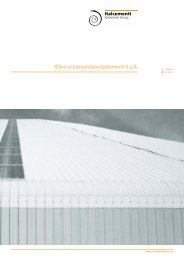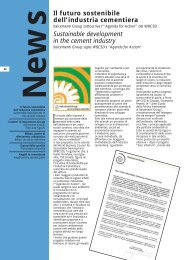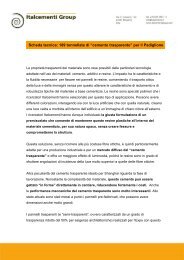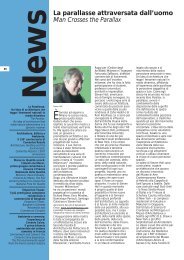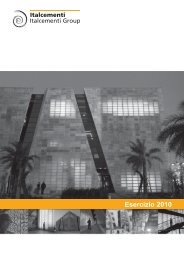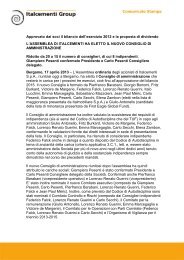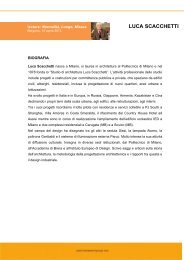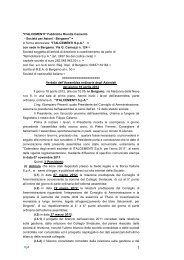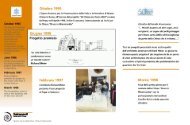Report 2010 - Italcementi Group
Report 2010 - Italcementi Group
Report 2010 - Italcementi Group
You also want an ePaper? Increase the reach of your titles
YUMPU automatically turns print PDFs into web optimized ePapers that Google loves.
22.8 Hedge Accounting<br />
The effects arising from application of hedge accounting rules are summarized below.<br />
The specific equity reserve reflects fair value gains and losses on the effective component of cash flow hedges<br />
only.<br />
New derivative instruments recognized in equity totaled +2.2 million euro at December 31, <strong>2010</strong> (-2.7 million<br />
euro at December 31, 2009). The eliminated portion of the reserve relating to instruments that expired in <strong>2010</strong><br />
amounted to +21.4 million euro at December 31, <strong>2010</strong>, compared with +11.5 million euro at December 31,<br />
2009. The changes in equity relating to derivatives contracted in 2009 and still in portfolio at December 31,<br />
<strong>2010</strong>, amounted to -12.0 million euro (-45.7 million euro at December 31, 2009).<br />
The non-effective component of cash flow hedges in portfolio at December 31, <strong>2010</strong>, recognized in profit and<br />
loss was immaterial in <strong>2010</strong> (+0.4 million euro in 2009).<br />
With reference to fair value hedges in portfolio at December 31, <strong>2010</strong>, the amount taken to profit and loss<br />
totaled +6.5 million euro for <strong>2010</strong> (-26.1 million euro for 2009). Recognized amounts attributable to underlying<br />
risk hedged during the year totaled -6.7 million euro at December 31, <strong>2010</strong> (+26.1 million euro at December<br />
31, 2009). These amounts are taken to profit and loss as gains and losses on interest- and exchange-rate<br />
derivatives (note 30).<br />
Liquidity risk<br />
Credit risk<br />
In compliance with <strong>Group</strong> procedures, customers electing extended terms of payment are vetted for credit<br />
worthiness before and during the life of the contract. Credit checks take the form of customer-balance<br />
monitoring by the administrative department, whose procedures also regulate provisions for overdue<br />
receivables at regular intervals.<br />
The concentration of trade credit risks is limited by virtue of the <strong>Group</strong>’s broadly based and uncorrelated<br />
customer portfolio. For this reason, management believes that no further provisions for credit risks will be<br />
necessary beyond the amounts normally provided for uncollectible and doubtful receivables.<br />
Counterpart risk<br />
Exchange- and interest-rate instruments are transacted only with counterparts with high ratings, selected on<br />
the basis of a number of criteria: ratings attributed by specialist agencies, assets and equity as well as the<br />
nature and maturity of transactions. The majority of counterparts are leading international banks.<br />
No financial instruments are negotiated with counterparts in geographical regions exposed to political or<br />
financial risks (all counterparts are in Western Europe or in the USA).<br />
At December 31, <strong>2010</strong>, the amount of 217.7 million euro due to <strong>Italcementi</strong> S.p.A. from the Calcestruzzi group<br />
(on intercompany current accounts) presented no risks other than that already contemplated when the<br />
<strong>Italcementi</strong> interest in the Calcestruzzi group was tested for impairment.<br />
126




